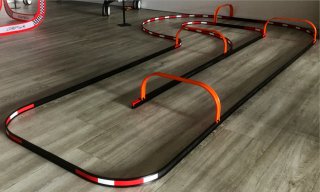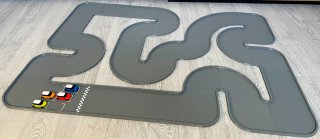A printable race track systems for remote controlled cars.
The project contains designs for a modular race track system aimed at remote controlled cars. The parts are designed using a scripting language, processed by OpenSCAD. There is no ready to use 3D model files in the source code. If you are interested in such files, please look at the released versions which contains 3D model files built with default parameters. However, if you want to customize these parts, tailoring them with your measures, you should rather download the source code and then tweak the configuration files before generating your own 3D model files.
The project contains two different systems, each targeting a particular RC car scale:
Please refer to the readme file for each variant in order to get the proper documentation.
Note: the scales are given as an estimate, not all scales have been tested. The
1/24 to 1/32variant has been tested with1/28scale models, while the1/64 to 1/76variant has been tested with1/76models.
To properly use the project you first need to do some installations steps.
First of all you need OpenSCAD to be installed. To do so, please go to the OpenSCAD download page, an get the version suitable for your operating system.
The source code is hosted on a Git repository. To get it you can either download a zip file, or clone the repository locally.
The source code can be downloaded from the GitHub repository.
You can download it as zip file from this link.
As the project is using a shared library, that is not supplied with the package, you will need to also download it.
Download the zip file from this link.
Then extract its content inside the folder lib/camelSCAD. Please make sure the folder directly contains the library and not an intermediate folder like lib/camelSCAD/camelSCAD-main. If this is the case, please move the content one folder up and delete the extra folder.
Note: the easiest way is to call the init.sh script, that will take care of this for you.
A git tool is needed if you intend to get the source code from the git repository. You can download one either from the main git website, or from GitHub.
Once you have your git tool installed, open a console window, select a project folder (create it if needed), then run the following commands:
git clone https://github.com/jsconan/rc-tracks.git
cd rc-tracks
git submodule init
git submodule update
The source code should have been downloaded, as well as the libraries.
Note: you can also use a graphical interface tool. In this case, please make it can also install the submodules.
Note 2: the easiest way is to call the init.sh script, that will take care of this for you.
The configuration for each system may be changed locally. To not collide with changes in the main implementation, the configuration files are not versioned. Instead, you will find -dist files that contain a copy of the typical configuration.
From a fresh copy of the project, you will need first to create these configuration files. The easiest way is to call the init.sh script, that will take care of this for you. The configuration files will also be checked and created if needed each time the render.sh script is called.
This initial creation of the configuration files could also be done manually. Here is how:
-
Go to the
configfolder -
Copy any of the files having a
-distsuffix in their name to a file without this suffix.Example: copy
config-dist.scadtoconfig.scad
Please refer to the readme file for each variant in order to get the proper documentation.
In each system, the parts are all located into the parts folder. They can all be opened separately in OpenSCAD and rendered.
However, it is possible to render all parts in batch. Each system proposes a script render.sh to take care of this.
This is a command-line tool, which accept several parameters. By default, it will render the preset selected in the config.
It is possible to select another preset, as well as set a different number of cells for the containers.
The parameter -h make it show the help.
If the slicer PrusaSlicer is installed, running the command render.sh -s will produce the G-code from the rendered STL files and using the setting from the file config/config.ini.
Please refer to the readme file for each variant in order to get the proper documentation.
For each system, when using the built-in script to render/slice the models in batch, you can also add custom post-processing scripts. There is one for render.sh and one for slice.sh. They are respectively named post-render.sh and post-slice.sh.
As these script can be defined locally, they are not part of the versioned content. Instead, you can find sample files at post-render-dist.sh and post-slice-dist.sh. To use them, you need to:
- copy the dist file to a local file, for example:
cp post-render-dist.sh post-render.sh. - you need to make sure the file is executable:
chmod +x post-render.sh. - finally, add you own commands to the copy.
Please refer to the readme file for each variant in order to get the proper documentation.

